A Novel Approach to Assess Motor Outcome of Deep Brain Stimulation Effects in the Hemiparkinsonian Rat: Staircase and Cylinder Test
Summary
Deep brain stimulation (DBS) is an effective treatment option for Parkinson’s disease. We established a study design to screen novel stimulation paradigms in rats. The protocol describes the use of the staircase test and cylinder test for motor outcome assessment in DBS treated hemiparkinsonian rats.
Abstract
Deep brain stimulation of the subthalamic nucleus is an effective treatment option for Parkinson's disease. In our lab we established a protocol to screen different neurostimulation patterns in hemiparkinsonian (unilateral lesioned) rats. It consists of creating a unilateral Parkinson's lesion by injecting 6-hydroxydopamine (6-OHDA) into the right medial forebrain bundle, implanting chronic stimulation electrodes into the subthalamic nucleus and evaluating motor outcomes at the end of 24 hr periods of cable-bound external neurostimulation. The stimulation was conducted with constant current stimulation. The amplitude was set 20% below the individual threshold for side effects. The motor outcome evaluation was done by the assessment of spontaneous paw use in the cylinder test according to Shallert and by the assessment of skilled reaching in the staircase test according to Montoya. This protocol describes in detail the training in the staircase box, the cylinder test, as well as the use of both in hemiparkinsonian rats. The use of both tests is necessary, because the staircase test seems to be more sensitive for fine motor skill impairment and exhibits greater sensitivity to change during neurostimulation. The combination of the unilateral Parkinson model and the two behavioral tests allows the assessment of different stimulation parameters in a standardized way.
Introduction
Deep brain stimulation of the subthalamic nucleus (STN) is an effective treatment option for Parkinson's disease1 and other movement disorders. The underlying mechanisms are still poorly understood and multifactorial, but a key feature is the modulation of neuronal network activity by repetitive depolarization of axons in the vicinity of the stimulating electrode2-4. High-frequency (>100 Hz) stimulation is required for a beneficial effect in most brain targets and for most indications of DBS. Side effects of deep brain stimulation result from inadvertent coactivation of other fibers, which are covered by the stimulation volume and which subserve different functions, such as the pyramidal tract. Hence, it would be desirable to develop stimulation parameters, which preferentially activate beneficial neural elements, while avoiding the coactivation of side effect elements5,6. Although neurophysiology may offer such fine tuning options of DBS, the scientific progress has been minimal during the past two decades, because programming strategies have primarily been assessed by "trial and error" in patients and restricted by the limited programming options of commercially available DBS devices, rather than using neurophysiological insight and defined experimental settings to systematically explore the full parameter space.
To overcome the translational roadblock in DBS research we are proposing a protocol to screen alternative stimulation parameters in rodent models of Parkinsonism prior to clinical exploration. Unilateral Parkinson's disease in rats is modeled using 6-hydroxydopamine injections into the right medial forebrain bundle7,8. The resulting lesion, described further as hemiparkinsonian, is assessed in the apomorphine test by evaluation of rotation score after low dose apomorphine injection and confirmed post mortem by tyrosine hydroxylase immunohistochemistry. The method is easy to apply and highly reproducible, while bearing a low mortality and morbidity. The resulting motor deficits are very discrete7,8; the animals exhibit a slight impairment of the contralateral left paw during both spontaneous exploration and complex grasping behavior9,10.
To assess the effectiveness of deep brain stimulation protocols tests are required which allow measuring a quick and reliable change in motor performance and can be repeated over time with different neurostimulation settings. Several groups have proposed different stimulation approaches and different tests to assess the motor functions in rats11 with highly variable and inconsistent outcomes11-14. This forced us to choose a set of tests with high predict validity and complementarity. Additionally, for assessment of motor outcome under deep brain stimulation conditions, tests were favored which could be performed by animals connected via cable to the stimulus generator. For these purposes we established our test battery consisting of one test for paw use asymmetry and one test for skilled reaching. The study design is illustrated in Figure 1.
For spontaneous paw use we performed the cylinder test described by Shallert15, which is a widely used test for paw use during vertical exploration. No training of the animal is required. For the assessment of more complex grasping behavior we established the staircase test according to Montoya16. Our protocol is modified according to Kloth17. The rats are trained for a period of twelve days in reaching pellets from the test box. After the training period the test can be applied to measure the complex grasping behavior by counting the success rate described as number of pellets eaten. The article presents the detailed training in the staircase box as well as the performance of both behavioral tests under naïve, hemiparkinsonian and deep brain stimulation conditions.
Protocol
Animal experiments were approved by the University of Wuerzburg and the legal state authorities of Lower Franconia in accordance with the animal protection guidelines and European Communities Council guidelines (approval number: 55.2-2531.01 76/11). All efforts were made to minimize pain or discomfort of the animals used.
Note: Electrode implantation was performed as described elsewhere18.
1. Cylinder Test (Figure 2)
- Prepare a clear plastic glass cylinder (height: 40 cm, diameter: 19 cm) by cleaning the cylinder with a 0.1% acetic acid solution.
- Prepare cards with date of experiment and each rat's identification number.
- Place two mirrors in 90° angle behind the cylinder.
- Place the camera in front of the cylinder such that the distance between the camera and the cylinder allows a good view of the paws.
- Place the rat in the transport box.
Note: The animals should be handled by the experimenter prior to the test to avoid stress. - Transport the rat from home cage to the cylinder using the transport box.
- Place the rat in the cylinder (Figure 3).
- Always perform all behavioral tests at the same time of the day to avoid circadian differences in activity. If the animal is connected to the stimulus generator by cable make sure the cable is not twisted during the experiment.
- Press the "record" button on camera. Show the card with the actual date of experiment and rat's identification number to the camera. Start recording.
- After five minutes, remove the animal from the cylinder and put it back into the home cage using the transport box.
- Clean the cylinder with a 0.1% acetic acid solution.
- Evaluate the paw use from recorded video by counting the left and right paw wall contacts (paw use in percent) as well as rearings (standing on hind paws with or without supporting on the cylinder wall). The cylinder test can be also evaluated automatically by an appropriate software.
Note: A healthy rat uses both paws equally. The hemiparkinsonian rat uses the paw affected due to lesion a lesser extent.
2. Staircase Test (Figure 4)
- Acquisition Phase
- One day prior to the training familiarize the animals with the pellets used in the Staircase test.
- Optional: To increase the animal's motivation use a dietary restriction (10-15 g of standard laboratory chow to maintain body weight at 90% of the free feeding level16). However, this is not obligatory to achieve a positive training effect. This study was conducted without food restriction.
- Prepare a clear plastic glass staircase box (height: 34.5 cm, length: 35.5 cm, width: 12 cm and narrow compartment 6 cm) by cleaning the box with a 0.1% acetic acid solution. Note: The staircase box is a two-compartment-box with a raised platform and two stairs in the narrow compartment. The left steps on the stairs in the narrow compartment can be reached only with the left paw, the right steps only with the right paw.
Note: The standard staircase boxes consist of two compartments with a lid, if it is to be used for experiments with rats stimulated via cable, use a high box without lid. - Remove the staircase and fill the wells on each step with eight 45 mg pellets.
- Insert the staircase and put eight additional pellets on the heightened platform.
- Place the rat in the transport box.
- Transport the rat from home cage to the staircase box using the transport box.
- Place the rat in the staircase box (Figure 5).
- After five minutes, remove the animal from the staircase box and put it back into the home cage using the transport box.
- Note how many pellets were eaten from platform and (eventually) from right and left staircase.
- Refill the staircase by filling the wells on each step with eight 45 mg pellets.
- Clean the staircase box with a 0.1% acetic acid solution and place the additional pellets on the platform.
- Repeat this procedure (acquisition phase) three days in a row.
Note: All experiments described were performed on male Sprague Dawley rats. The duration of the different training modules can differ in rats of different strain, sex and vender.
- One day prior to the training familiarize the animals with the pellets used in the Staircase test.
- Free Choice Test
- Clean the staircase box with a 0.1% acetic acid solution.
- Remove the staircase and fill the wells on each step with eight 45 mg pellets.
- Place the rat in the transport box.
- Transport the rat from home cage to the staircase box using the transport box.
- Place the rat in the staircase box.
- After five minutes, remove the animal from the staircase box and put it back into the home cage using the transport box.
Note how many pellets were eaten from right and left staircase. - Note: If the animals still have problems with grasping pellet, add some more on the platform where they can be easily reached.
- Refill the staircase by filling the wells on each step with eight 45 mg pellets.
- Clean the staircase box with a 0.1% acetic acid solution for the next animal.
- Repeat this procedure (free choice phase) three days in a row.
Note: The presented results were obtained by training conducted without a resting period between modules. Some groups prefer a resting day for consolidation, to support the training process.
- Forced Choice Test
- Clean the staircase box with a 0.1% acetic acid solution.
- Remove the staircase and fill the wells on each step on the left staircase with eight (first three days of the module) or four (consecutive three days of the module) 45 mg pellets.
- Perform the forced choice test on the side, where the impairment will occur.
Note: We perform the Parkinson lesion on the right hemisphere and therefore train selectively the left paw.
- Perform the forced choice test on the side, where the impairment will occur.
- Place the rat in the transport box.
- Transport the rat from home cage to the staircase box using the transport box.
- Place the rat in the staircase box.
- After five minutes, remove the animal from the staircase box and put it back into the home cage using the transport box.
- Note how many pellets were eaten from left staircase.
- Refill the staircase by filling the wells on each step with eight or four 45 mg pellets (number of pellets depends on training day).
- Clean the staircase box with a 0.1% acetic acid solution for the next animal.
- Repeat this procedure (forced choice phase) six days in a row.
- Data Acquisition
- Perform the experiment as described for the forced choice module (four pellets in each well on the left staircase) on two consecutive days. Calculate the success rate (number of pellets eaten) as mean of the two days.
Representative Results
All animals underwent a post mortem histological verification of both the dopaminergic lesion and the electrode location. Only animals with correct electrode placement inside the STN (Figure 6) and complete dopaminergic lesion (>90% loss of dopaminergic neurons in substantia nigra) were included into the results section (Figure 7).
The cylinder test performed under lesioned condition showed that the lesioned left paw use decreased from approximately 50% (naïve, healthy rat) to 15.11% (mean). Under regular 130 Hz stimulation following a 24 hr stimulation period (pulse width 60 µsec), which is the standard protocol in Parkinson's patients, the paw use increased to 21.9% (Figure 8). Due to a high standard deviation this difference is not statistically significant. The number of rearings showed no differences between sham and stimulated condition, but this parameter will be included in further studies as measurement of the rat's activity. The performance was apparently not disturbed by the stimulation cable (Figure 9).
All animals used in our deep brain stimulation study were able to learn the pellet reaching within the described timeline of twelve days. The mean success rate before lesioning was 13.5 out of 28 pellets (48.2%). After lesioning the mean success rate decreased significantly to 2.4 pellets (8.6%). It increased again to 7 pellets (25%) under regular 130 Hz stimulation at the end of a 24 hr stimulation period (Figure 10). The performance was not disturbed by the stimulation cable (Figure 7). The two motor tests were complementary in assessing motor deficits in the hemiparkinsonian rat and had a good predict validity based on the improvement under default therapeutic conditions. The stimulation cable seemed to have no impact on the test performance (Figure 11).
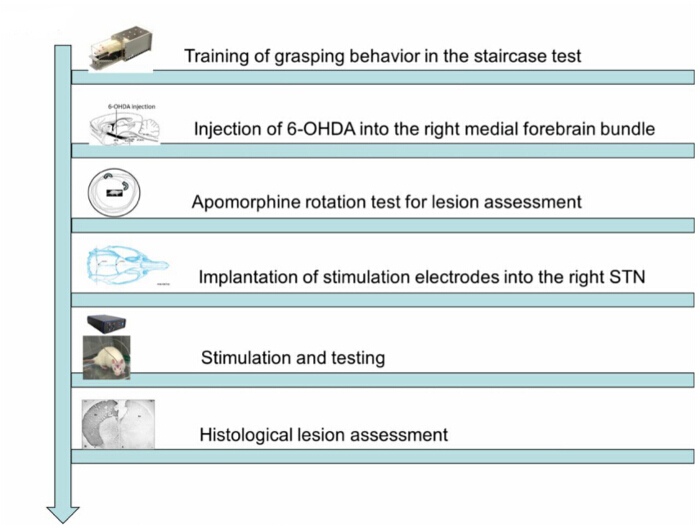
Figure 1: Study design. The single steps to conduct an experiment on different stimulation protocols in hemiparkinsonian rats. Please click here to view a larger version of this figure.
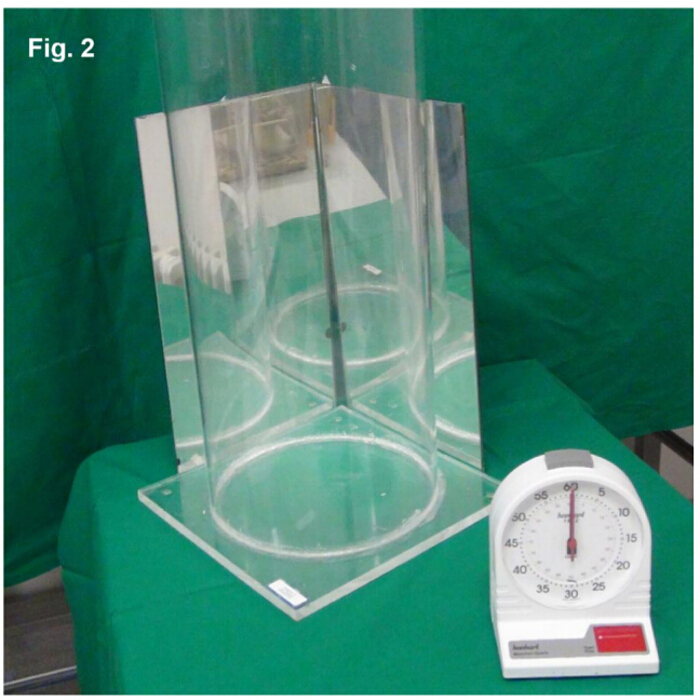
Figure 2: Cylinder test setup. The cylinder box arranged with mirrors. Please click here to view a larger version of this figure.
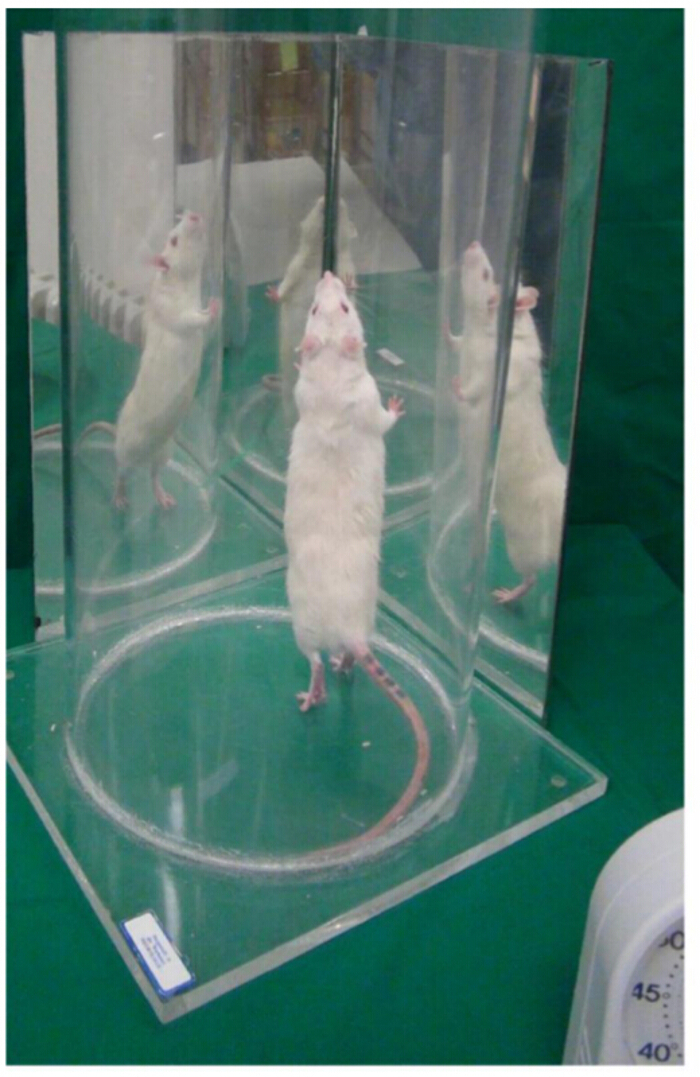
Figure 3: Cylinder test. A hemiparkinsonian rat during cylinder test. Please click here to view a larger version of this figure.
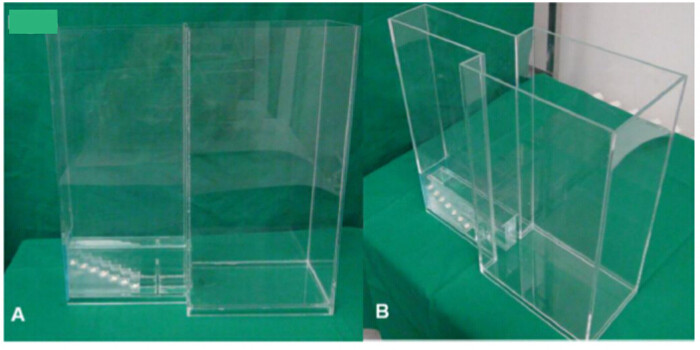
Figure 4: Staircase test setup. The staircase box arranged with pellets on left staircase. (A) side view, (B) view from above. Please click here to view a larger version of this figure.
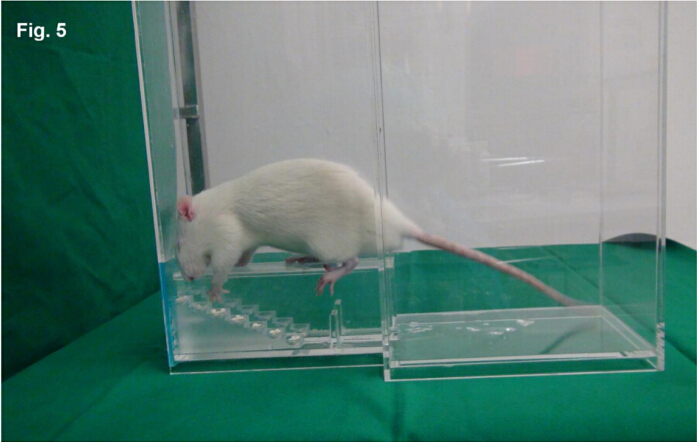
Figure 5: Staircase test. A hemiparkinsonian rat during staircase test. Please click here to view a larger version of this figure.
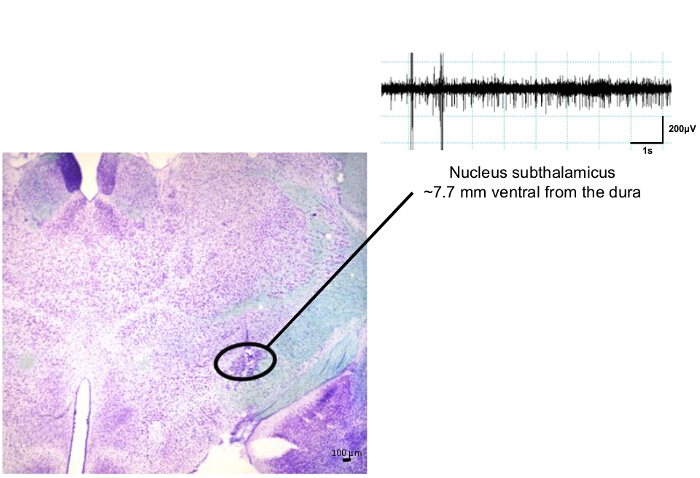
Figure 6: Stimulation site. Coronary rat brain section (thionine staining) with right STN indicated by black circle and the corresponding spike signal recorded during implantation surgery. Please click here to view a larger version of this figure.
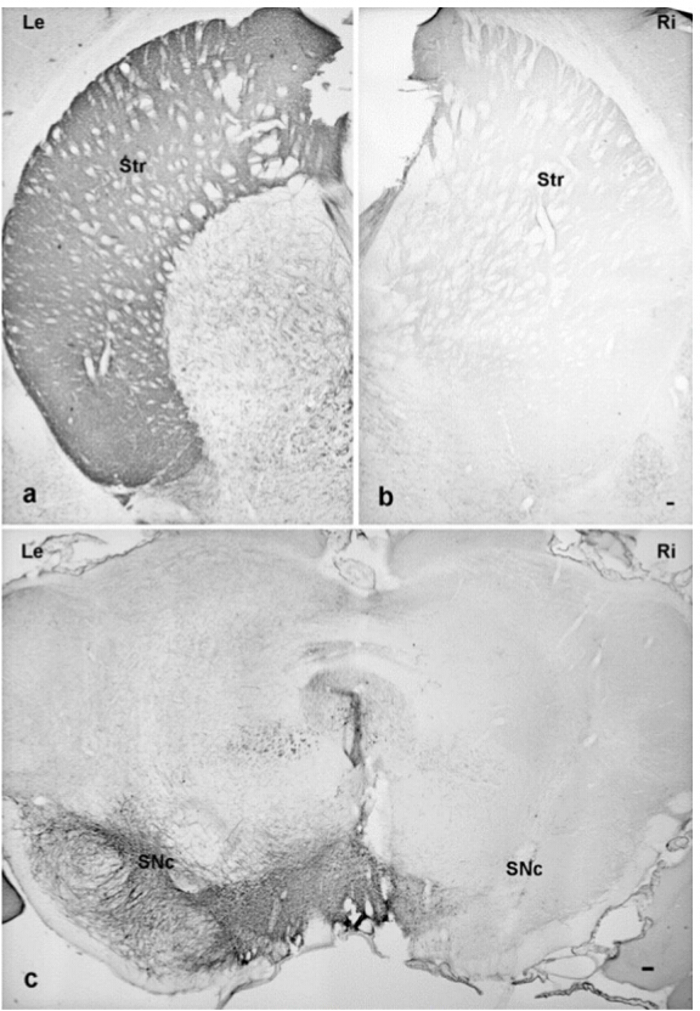
Figure 7: Documentation of the 6-OHDA lesion. Immunohistochemistry for tyrosine hydroxylase, a marker enzyme of dopaminergic neurons. Coronary section of the rat brain after unilateral 6-OHDA lesion. Comparison of the left healthy side (Le) and the lesioned right side (Ri). Unilateral loss of dopaminergic fibers in the Striatum (a) and dopaminergic neurons in the Substantia nigra pars compacta (SNc), (c). Scale bar = 100 µm. Please click here to view a larger version of this figure.
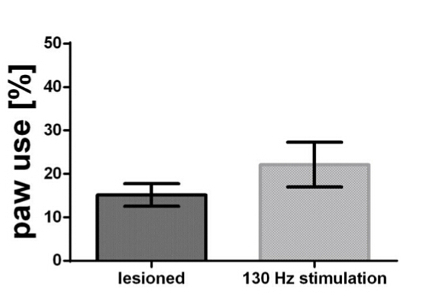
Figure 8: Paw use cylinder test. The results of the cylinder test expressed as contralateral (affected due to lesion) paw use in percent (100% — ipsilateral paw use [%]), under various conditions (lesioned vs. 130 Hz stimulation). The data are given as mean ± SEM, n = 7. Please click here to view a larger version of this figure.
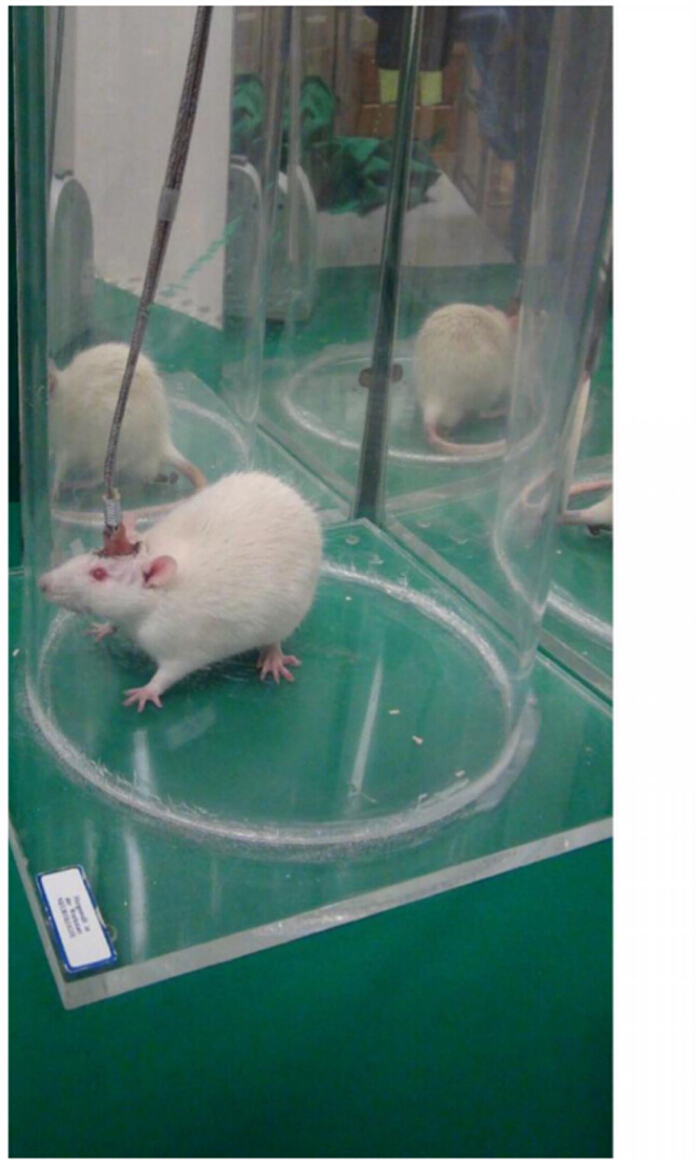
Figure 9: Cylinder test with stimulation cable. A stimulated hemiparkinsonian rat during cylinder test. Please click here to view a larger version of this figure.
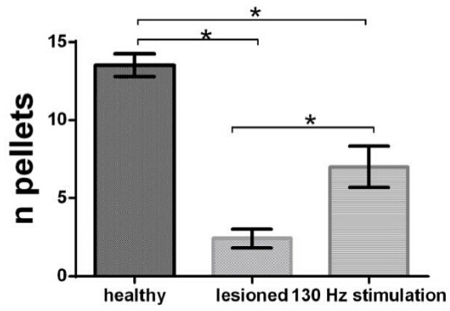
Figure 10: Success rate in the staircase test. The results of the staircase test expressed as number of grasped pellets under various conditions (healthy, lesioned and 130 Hz stimulation). The data are given as mean ± SEM, n = 7. P <0.05 (*) was considered statistically significant (one way ANOVA + t-test). Please click here to view a larger version of this figure.
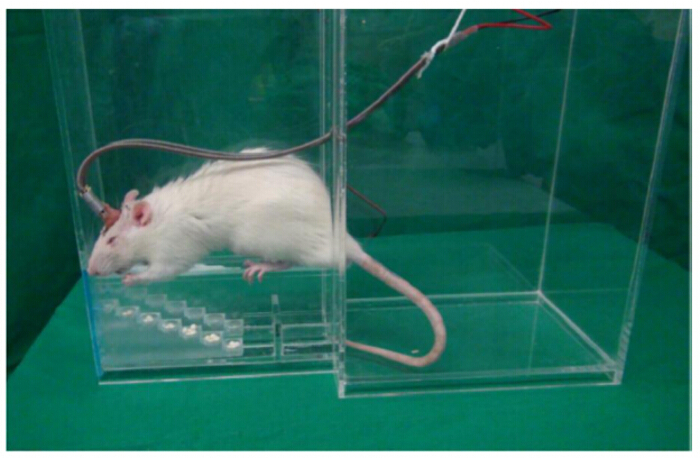
Figure 11: Staircase test with stimulation cable. A stimulated hemiparkinsonian rat during staircase test. Please click here to view a larger version of this figure.
Discussion
This article describes a detailed training protocol for the cylinder and staircase test. The latter is designed to assess complex grasping behavior and fine motor movement due to skilled reaching in rats16,17. The outcome measurement is expressed as number of pellets eaten during the test, which is an objective measurement. The protocol can be used in rat models for Parkinson's disease and other motor disease models. The cylinder test involves a simple approach to evaluate paw use in rats. It requires no training and can be used in a highly standardized way, by blinded evaluation from a videotape. We choose these tests among others (open field, single pellet reaching test, and gait analysis) for several reasons. Both tests reliably show the paw impairment created in our Parkinson's model10. They are relatively robust in outcome and the test results can be obtained in a highly objective manner. Both tests can be used repeatedly in short time intervals. In the staircase test, pellet grasping increases during the learning phase and stabilizes on an individual plateau level, so after reaching plateau, it can be used without having to consider training-dependent improvement over time16,20.
Whereas the cylinder test is easy to apply, rats can became bored and inactive. The animals can be motivated by darkness (performing the test with red light) or late in the light-dark-cycle. The measurement of rearings is helpful to monitor the rat's normal activity. For successful staircase training, it is crucial to motivate the animals during the acquisition phase. It is important to ensure that the rat is able to grab some pellets at the first grasping approach. The immediate positive reward results in good training effects in later phases. Another critical step occurs when the rat is not interested in the task. In this case it may be necessary to apply a mild food restriction until the proper motivation level is reached.
Another important issue for our study design was a good predictive validity of the established procedure. The design was planned to be used as a screening platform for novel stimulation protocols. Although deep brain stimulation is a treatment option not only for Parkinson's disease, but also for tremor, depression, compulsive disorders, dystonia and many other conditions, the mechanisms lying behind it effectiveness remains poorly understood1,21. To address novel, rational based stimulation approaches a good animal model is required.
A more pragmatic approach forced us to choose a behavioral setup which could be performed by animals connected via cable to the stimulation device. The cylinder was appropriate for this purpose. The commercially available staircase box has a lid, therefore we designed a copy of the original box, which is higher and without a lid. This allows to test performance during deep brain stimulation. The problem of cable driven stimulation is common in preclinical research. There are some devices enabling stimulation without a cable but their use is still limited22-24. For our research we have to set different stimulation patterns and also perform long term stimulation. At present this can be done only by cable driven stimulation because it allows a quick reprogramming of various stimulation features without touching the animal. In this respect this study design is suited for most research groups dealing with motor outcome in deep brain stimulated rats.
In summary, this manuscript presents a full length protocol for studying motor outcome in hemiparkinsonian rats under different experimental DBS conditions. It describes a detailed protocol for training in the staircase box, as well as the use of the cylinder test. Problems associated with the described training method may occur when rats of different strain, sex or vender are used. Rats differ according to sex and strain in their performance of behavioral tests20,25,26. In female rats the estrus cycle has also an impact on their daily performance27. To deal with this limitation, female rats can be housed without males which desynchronizes the estrus cycle28. It can also be necessary to adjust the duration of the training phase according to individual learning curves in outbreed rat strains. Food restriction often used in behavioral tests should be applied carefully. Food deprivation may increase motivation but on the other hand decreases the accuracy of grasping20,29. The described behavioral battery, in combination with the hemiparkinsonian model, can be used to study different treatment options and their impact on motor outcome. For deep brain stimulation of the subthalamic nucleus, this study design has a high predictive validity.
Divulgations
The authors have nothing to disclose.
Acknowledgements
This work was supported by Interdisziplinäres Zentrum für Klinische Forschung (IZKF), University Clinics Würzburg, Germany (project N-215).
Materials
| Staircase box witout lid | Glas Keil, Germany | custom made | |
| Cylinder box | Glas Keil, Germany | custom made | |
| Dustless precision pellets, 45 mg | Bio Serv | F0021 |
References
- Fasano, A., Lozano, A. M. Deep brain stimulation for movement disorders: 2015 and beyond. Current opinion in neurology. , (2015).
- McIntyre, C. C., Savasta, M., Kerkerian-Le Goff, L., Vitek, J. L. Uncovering the mechanism(s) of action of deep brain stimulation: activation, inhibition, or both. Clinical neurophysiology : official journal of the International Federation of Clinical Neurophysiology. 115, 1239-1248 (2004).
- Deniau, J. M., Degos, B., Bosch, C., Maurice, N. Deep brain stimulation mechanisms: beyond the concept of local functional inhibition. The European journal of neuroscience. 32, 1080-1091 (2010).
- Modolo, J., Legros, A., Thomas, A. W., Beuter, A. Model-driven therapeutic treatment of neurological disorders: reshaping brain rhythms with neuromodulation. Interface focus. 1, 61-74 (2011).
- Groppa, S., et al. Physiological and anatomical decomposition of subthalamic neurostimulation effects in essential tremor. Brain : a journal of neurology. 137, 109-121 (2014).
- Reich, M. M., et al. Short pulse width widens the therapeutic window of subthalamic neurostimulation. Annals of clinical and translational neurology. 2, 427-432 (2015).
- Blandini, F., Armentero, M. T., Martignoni, E. The 6-hydroxydopamine model: news from the past. Parkinsonism & related disorders. 14, 124-129 (2008).
- Bove, J., Perier, C. Neurotoxin-based models of Parkinson’s disease. Neurosciences. 211, 51-76 (2012).
- Metz, G. A., Tse, A., Ballermann, M., Smith, L. K., Fouad, K. The unilateral 6-OHDA rat model of Parkinson’s disease revisited: an electromyographic and behavioural analysis. The European journal of neuroscience. 22, 735-744 (2005).
- Miklyaeva, E. I., Castaneda, E., Whishaw, I. Q. Skilled reaching deficits in unilateral dopamine-depleted rats: impairments in movement and posture and compensatory adjustments. The Journal of neuroscience : the official journal of the Society for Neuroscience. 14, 7148-7158 (1994).
- Li, X. H., et al. High-frequency stimulation of the subthalamic nucleus restores neural and behavioral functions during reaction time task in a rat model of Parkinson’s disease. Journal of neuroscience research. 88, 1510-1521 (2010).
- Darbaky, Y., Forni, C., Amalric, M., Baunez, C. High frequency stimulation of the subthalamic nucleus has beneficial antiparkinsonian effects on motor functions in rats, but less efficiency in a choice reaction time task. The European journal of neuroscience. 18, 951-956 (2003).
- Fang, X., Sugiyama, K., Akamine, S., Namba, H. Improvements in motor behavioral tests during deep brain stimulation of the subthalamic nucleus in rats with different degrees of unilateral parkinsonism. Brain research. 1120, 202-210 (2006).
- Lindemann, C., Krauss, J. K., Schwabe, K. Deep brain stimulation of the subthalamic nucleus in the 6-hydroxydopamine rat model of Parkinson’s disease: effects on sensorimotor gating. Behavioural brain research. 230, 243-250 (2012).
- Schallert, T., Fleming, S. M., Leasure, J. L., Tillerson, J. L., Bland, S. T. CNS plasticity and assessment of forelimb sensorimotor outcome in unilateral rat models of stroke, cortical ablation, parkinsonism and spinal cord injury. Neuropharmacology. 39, 777-787 (2000).
- Montoya, C. P., Campbell-Hope, L. J., Pemberton, K. D., Dunnett, S. B. The ‘staircase test’: a measure of independent forelimb reaching and grasping abilities in rats. Journal of neuroscience. 36, 219-228 (1991).
- Kloth, V., Klein, A., Loettrich, D., Nikkhah, G. Colour-coded pellets increase the sensitivity of the staircase test to differentiate skilled forelimb performances of control and 6-hydroxydopamine lesioned rats. Brain research bulletin. 70, 68-80 (2006).
- Fluri, F., Volkmann, J., Kleinschnitz, C. Microelectrode guided implantation of electrodes into the subthalamic nucleus of rats for long-term deep brain stimulation. JoVE. , (2015).
- Paxinos, G., Watson, C. . The rat brain in stereotactic coordinates. , (2008).
- Nikkhah, G., Rosenthal, C., Hedrich, H. J., Samii, M. Differences in acquisition and full performance in skilled forelimb use as measured by the ‘staircase test’ in five rat strains. Behavioural brain research. 92, 85-95 (1998).
- Angelov, S. D., Dietrich, C., Krauss, J. K., Schwabe, K. Effect of Deep Brain Stimulation in Rats Selectively Bred for Reduced Prepulse Inhibition. Brain stimulation. , (2014).
- de Haas, R., et al. Wireless implantable micro-stimulation device for high frequency bilateral deep brain stimulation in freely moving mice. Journal of neuroscience methods. 209, 113-119 (2012).
- Heo, M. S., et al. Fully Implantable Deep Brain Stimulation System with Wireless Power Transmission for Long-term Use in Rodent Models of Parkinson’s Disease. Journal of Korean Neurosurgical Society. 57, 152-158 (2015).
- Gut, N. K., Winn, P. Deep brain stimulation of different pedunculopontine targets in a novel rodent model of parkinsonism. J. Neurosci. 35, 4792-4803 (2015).
- Whishaw, I. Q., Gorny, B., Foroud, A., Kleim, J. A. Long-Evans and Sprague-Dawley rats have similar skilled reaching success and limb representations in motor cortex but different movements: some cautionary insights into the selection of rat strains for neurobiological motor research. Behavioural brain research. 145, 221-232 (2003).
- Honndorf, S., Lindemann, C., Tollner, K., Gernert, M. Female Wistar rats obtained from different breeders vary in anxiety-like behavior and epileptogenesis. Epilepsy research. 94, 26-38 (2011).
- Jadavji, N. M., Metz, G. A. Sex differences in skilled movement in response to restraint stress and recovery from stress. Behavioural brain research. 195, 251-259 (2008).
- Kucker, S., Tollner, K., Piechotta, M., Gernert, M. Kindling as a model of temporal lobe epilepsy induces bilateral changes in spontaneous striatal activity. Neurobiology of disease. 37, 661-672 (2010).
- Smith, L. K., Metz, G. A. Dietary restriction alters fine motor function in rats. Physiology & behavior. 85, 581-592 (2005).

